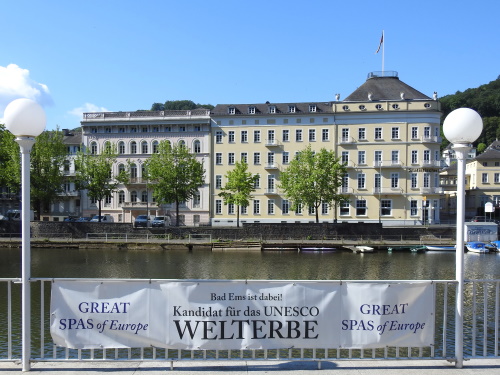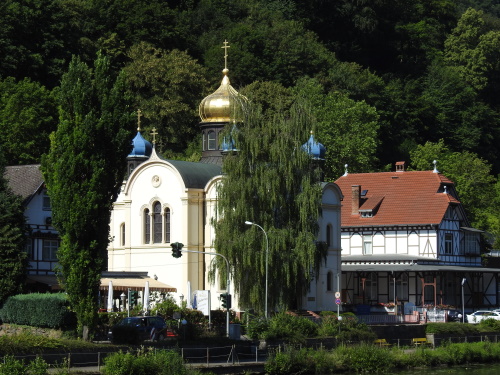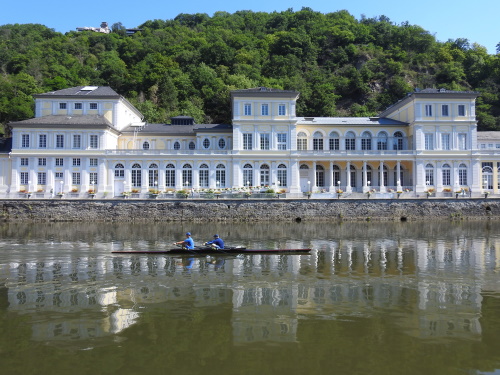Blog TWHS Visits
Great Spas: Bad Ems
The Great Spas of Europe will be discussed at the 2020 WHC meeting, whenever it will be rescheduled. I had ‘ticked’ it already in 2014 with a visit to Spa in Belgium and of course, like 553 others on this website, had been to the future double-nominated City of Bath in the UK as well. But with a serial transnational nomination such as this, it is always interesting to visit locations in other countries. Germany has 3 Spas left in the line-up for the 2020 nomination: Baden-Baden, Bad Kissingen and Bad Ems (Bad Homburg, Wiesbaden and Bad Pyrmont have been dropped). On my way back home from Worms I stopped for a few hours in Bad Ems, where they were eagerly awaiting the decision:
Bad Ems lies in the vicinity of Koblenz, close to the Upper Middle Rhine Valley WHS but on the river Lahn instead of the Rhine. The town with about 9,000 inhabitants extends on both river banks. It is therefore nice to walk along the waterfront and as many as four bridges allow you to get to that other side: two only for pedestrians and two also for motorized traffic. One actually has the best views of the buildings from across the wide river.
In the 19th century Bad Ems attracted visitors from all over the world to enjoy its spa facilities. Among them the Tsars Nicholas I and Alexander II from Russia and the writer Fyodor Dostoevsky, who had summer residences here. They were attracted by the beautiful setting of the town and its apparent health benefits, but they also enjoyed socializing with the European aristocracy. This Russian link has been visually preserved in Ems by way of the Russian-Orthodox church which is still in use.
The town still relies for its income on the spa business, although it has gone through hard times in the late 20th, early 21st century. When I took a walk along the waterside around 10 on a Sunday morning, I only came across a man with a can of beer in his hand (not his first of the day) and I saw someone smoking a cigarette on one of the park benches. The many restaurant terraces were also still waiting for customers. To be honest it all came across quite boring and old-fashioned, although well-maintained.
The only thing that sparked my interest was a sign for a historical hiking route, partly uphill through the forest and with panoramic views of the pretty setting of Bad Ems. But with an indicative duration of 3 hours, I found that too long for this short visit. So I just walked back to my starting point via the other side of the river. From that side you have a good view of the monumental Neo-Baroque buildings of the Casino and the Kurhaus, both originating in the 18th century but further extended by Prussian emperor William I in the late 19th century.
Bad Ems surely is one of the minor locations among the 11 remaining Great Spas of Europe. It seems to become the kind of town that enters the WH List piggybacking on stronger partners: Bath has already proven to hold on its own, I liked Spa for its Art Nouveau and others on this website have reviewed Baden Baden and Karlovy Vary favourably. Ems actually has pulled off this trick before, it is already blessed with a WHS as it contributes 3 unremarkable locations to the 439 of the Frontiers of the Roman Empire WHS.
Els - 28 June 2020
Comments
pikkle 29 June 2020
Have been to all the TWHS German Spas (as well as many of the others) and while I find Bad Ems beautiful I am surprised Wiesbaden was left out...
Nan 28 June 2020
And I just visited Bad Pyrmont which was not included in the final nomination :(
It's worthwhile to point out that there are still plenty of Kurorte/Bäder in Germany. You can get a Kur (which some may consider a holiday) paid for by the health or retirement insurance. Which is why so many Kurorte/Bäder have remained open to this day.


